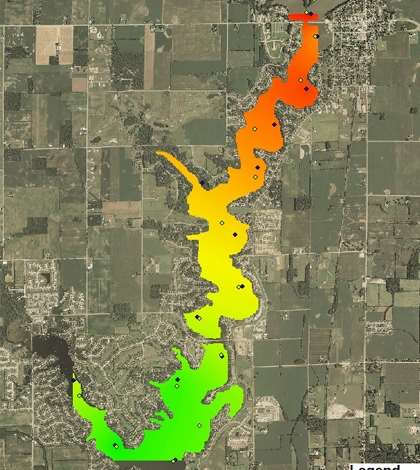Research refines remote sensing of cyanobacteria blooms

A map of chlorophyll distribution created from data collected on Morse Reservoir using boat-based sensors (Credit: Anthony Nguy-Robertson)
New findings could help water managers sharpen the tools they use to keep cyanobacteria, or blue-green algae, out of drinking water.
That’s important because cyanobacteria can make water taste and smell bad, and can even be toxic, resulting in vomiting, diarrhea, fever, muscle and joint pain and other symptoms.
Published in the Journal of Great Lakes Research, the study was conducted on three reservoirs in central Indiana—Eagle Creek, Geist and Morse—that provide drinking water for more than 800,000 people in greater Indianapolis.
Located just outside the city’s beltway, the reservoirs are popular getaways for watersports and fishing. But with heavy agriculture in their watersheds, all three have a history of nuisance algae growth and taste and odor issues related to high levels of phosphorus and nitrogen.
To determine where toxic algae blooms are at a given time, water managers collect remote sensing data on how the water column reflects sunlight, and feed that information into computer models—a more efficient technique than collecting water samples. They can use that information to protect drinking water and warn swimmers about potential danger from blue-green algae.
But to find cyanobacteria, remote sensors have to sort it out from non-toxic blooms and other suspended solids like sediment and leaf particles.
“That adds complexity to the models, so this study was trying to understand the optical properties of those individual components,” said lead author Anthony Nguy-Robertson, a postdoctoral researcher at the University of Nebraska-Lincoln who was at Indiana University-Purdue University Indianapolis during the project.
Each type of suspended solid has a unique way of reflecting and absorbing light. For the study, Nguy-Robertson and colleagues were particularly interested in the optical “signature” of phycocyanin, the pigment that gives cyanobacteria their blue-green hue. They also measured the optical properties of chlorophyll, minerals and dissolved organic matter.

Geist Reservoir has an agricultural watershed and is popular for recreation (Credit: Anthony Nguy-Robertson)
First the researchers used boats and airplanes to gather remote sensing data on how the water column reflected sunlight. Then they collected water samples and took them to the lab where they isolated each component and took more precise measurements using light of various wavelengths.
“The reflectance measurements in the field include everything all together,” Nguy-Robertson said. “You get a whole hodgepodge of stuff. In the lab we can sort the components out so we can say this component behaves in this certain way.”
Nguy-Robertson said the study is the first he’s aware of to take laboratory measurements of phycocyanin’s optical properties, due to the difficulty of extracting the pigment from cyanobacteria.
He said researchers will need to gather optical data on phycocyanin from around the world before they can build a reliable global model. In the meantime, the findings are most useful for local and regional water managers. They can plug in the information about phycocyanin to “teach” computer models to more accurately identify and respond to cyanobacteria based on remote sensing data.
“Rather than blanket-treating a whole reservoir with algaecide, they can target the areas that needed to be treated,” Nguy-Robertson said.
Top image: A map of chlorophyll distribution created from data collected on Morse Reservoir using boat-based sensors (Credit: Anthony Nguy-Robertson)




0 comments